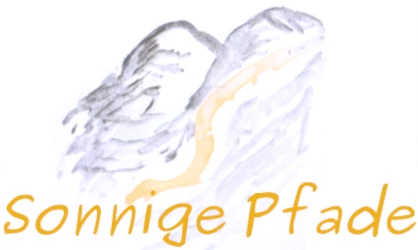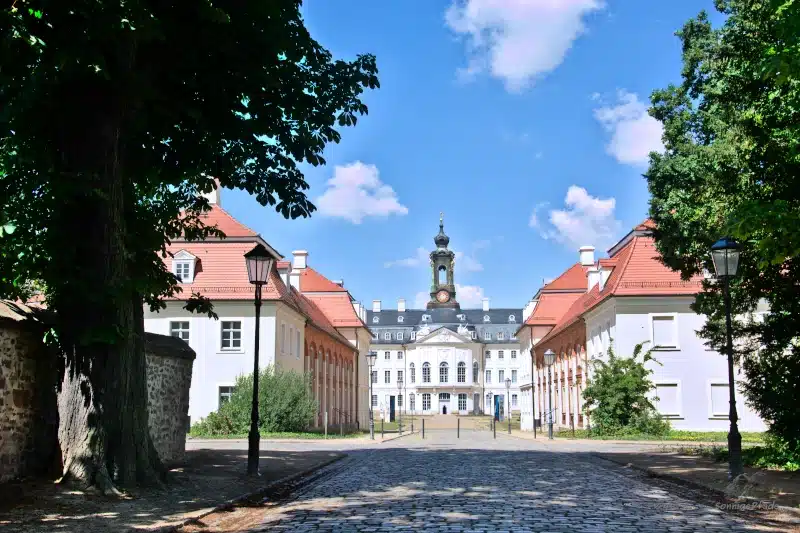
Even today, the Saxon money circle is occasionally referred to as a triangle with a mocking undertone: ‚In Chemnitz (and the surrounding area) it’s earned, in Leipzig it’s sold and in Dresden it’s squandered…‘ is the short formula. Truly, the Saxon court in Dresden was always a place where money was lavishly spent, although this also resulted in the creation of art treasures and buildings that are admired by the whole world.
But at least in the 18th century, a considerable part of the money on the way from Leipzig to Dresden probably got stuck halfway – in a small village in the forest, of all places: in Hubertusburg Castle in Wermsdorf. For it was there that the Saxon Electoral Court spent its autumn days hunting and holding court in the Wermsdorf Forest and the Dahlen Heath. So today there are two castles in Wermsdorf – the Old Hunting Lodge in Renaissance style and the Hubertusburg Castle – one of the largest Baroque hunting lodge complexes in Europe. Some even speak of the „Saxon Versaille„.
Hunting pleasure and courtly life – the Hubertusburg Palace is built
The construction of Hubertusburg Castle was announced on November 3, 1721 in Wermsdorf on the occasion of the annual Hubertus hunt. The old Renaissance hunting lodge had become too small for the growing Saxon court of the Elector. With the new castle Hubertusburg the ever larger Parforce – hunts of rushing celebrations should be framed and an appropriate court attitude over several weeks locally with all necessary servants become possible.
For this purpose, a new three-sided palace building was erected in a first construction phase from 1721 to 1723 by more than 700 building craftsmen. Wings were attached to both sides of the main palace to form a courtyard of honor. Of course, the architectural style corresponded to the Dresden Baroque, i.e. the current style of the time.
A baroque palace for great festivities
Then, from 1733 to 1752, Hubertusburg Castle was created with the palace in the dimensions visible today. A central building with a protruding oval vestibule, in which there is a magnificent staircase as well as the „Hubertus Hall“ on the upper floor. The oval risalit is crowned by a baroque ridge turret with clock and bell. The weather vane on the top is a gilded „jumping stag“. Altogether, the palace building is now a four-sided building, which encloses a rectangular courtyard. On the ground floor there is a palace chapel, which, however, is not recognizable as such from the outside. The fact that there is a Catholic chapel in Hubertusburg Castle at all is considered a concession by the Saxon Elector, who also reigns as King of Poland. Otherwise, Electoral Saxony is Protestant-oriented.
However, the large palace of Hubertusburg is only one part of the numerous buildings in the complex. A large palace courtyard is also enclosed by other buildings, including the palace of the Saxon prime minister, Count Heinrich von Brühl, as well as the commander of the par force hunt and the chief hunter.
The representative entrance to this courtyard is via a street from the (south)east on the visual axis to the vestibule and baroque ridge turret of Hubertusburg Castle.
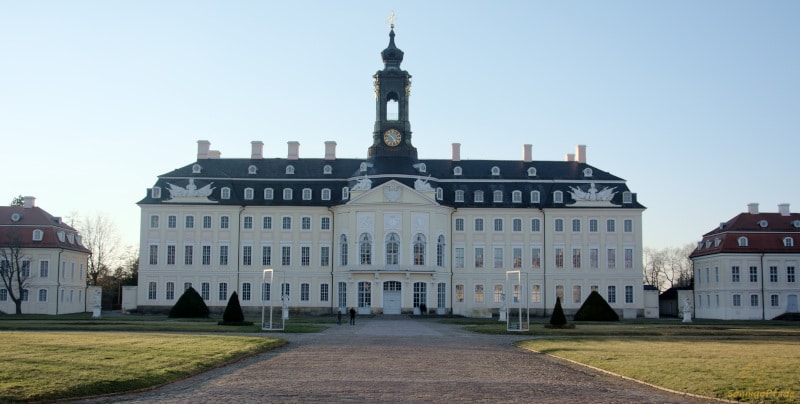
French hunting methods to demonstrate greatness
Parforce hunts were a fashion in French courts adopted at the end of the 18th century. Basically, they were hunts on horseback with a large pack of hounds to track down and bring in game. The amount of man and beast involved was immense. The pack of dogs alone could include up to 250 dogs – all of which had to be fed, cared for, trained and exercised. For this there were piqueurs, who had to provide only for these tasks. In addition, the aristocratic hunting parties needed a large number of suitable horses, some of which were changed during the hunts. Therefore, a horse doctor as well as farriers were employed, besides saddlers, servants and stable boys as a matter of course.
Horse stables, tournament track, riding arena… all this belonged to the ancillary facilities of Hubertusburg Castle in Wermsdorf.
A lot of personnel was also needed for the court keeping. From cooks and kitchen helpers to valets and chambermaids to „operating craftsmen“. Even the large grounds of Hubertusburg Castle did not always offer enough space for everyone. Thus, the Old Hunting Lodge in Wermsdorf was often used as servants‘ quarters during the court days at Hubertusburg Castle.
The annual highlight of the court hunts at Hubertusburg was the Hubertus hunt on November 3. Towards the end of November, the court of the Electorate of Saxony moved back to Dresden.
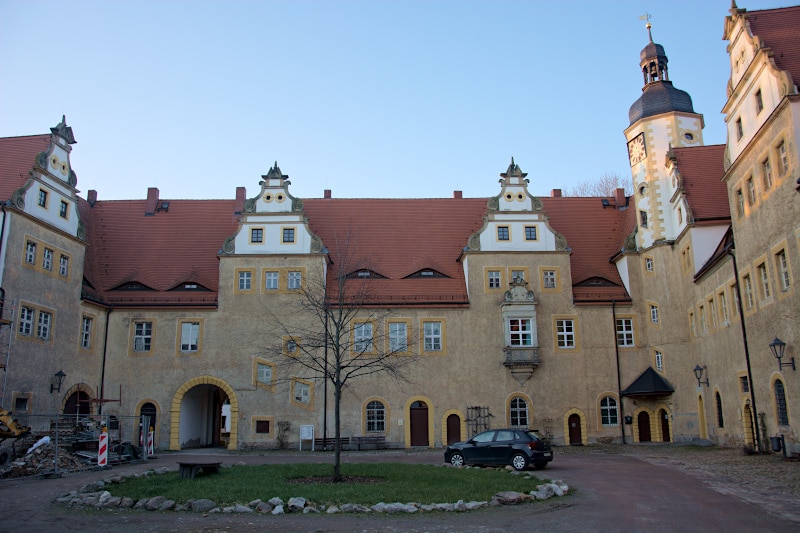
Saint Hubert – eponym for the Hubertusburg castle in Wermsdorf
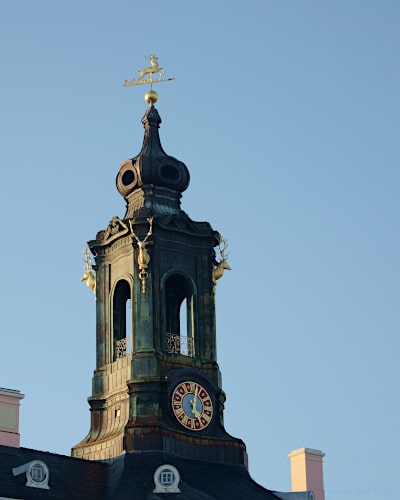
The name giver for the Hubertusburg castle was Hubertus, patron saint of hunting, who was venerated as a saint. He was actually called Hubert of Liège and lived between 655 and 727. Hubert spent some time of his life as a hermit in the Ardennes. He then became bishop of Maastricht and Liège. His suitability as patron saint of hunting is disputed, however, since according to legend he renounced hunting at the sight of a stag with a cross symbol. Thus, he is probably also the first confirmed opponent of hunting. The stag’s head with a cross between its antlers is the symbol of Hubertus and visitors will encounter it everywhere at Hubertusburg Castle.
Hubertusburg in the Seven Years‘ War – plundering and peace negotiations
Hubertusburg Castle in Wermsdorf played an important role at the end of the Seven Years‘ War. Even before that, from about 1748, the court of the Electorate of Saxony was in a state crisis. The main causes were the worsening financial situation and the increase in political tensions. In November 1755, the last court hunt took place before the Seven Years‘ War broke out in 1756. In the region in Central Europe, the Austrian Habsburg monarchy and the Kingdom of Prussia were primarily opposed to each other. The Electorate of Saxony, linked to the Habsburgs by marriage of the queen of Austrian descent, was caught in the middle.
The Elector Frederick August II, also King August III of Poland, and his prime minister Count von Brühl preferred to retreat to Warsaw. Nevertheless, Electoral Saxony was a war party on the side of the Austrians and suffered heavy destruction and plundering, mainly by Prussians. Since Saxon troops participated with Austrians in the devastation of Charlottenburg, Hubertusburg Castle in Wermsdorf was to be plundered in 1760 by order of the Prussian King Frederick II. However, Friedrich Adolf von der Marwitz, who was entrusted with this task, refused this order and fell into disgrace. A free battalion finally carries out the looting. Over a period of several months, the clock and bells were stolen, the copper roofing was torn off, and furniture and precious metals were taken away. The court chapel was spared from the looting through the courageous intervention of the court chaplain.
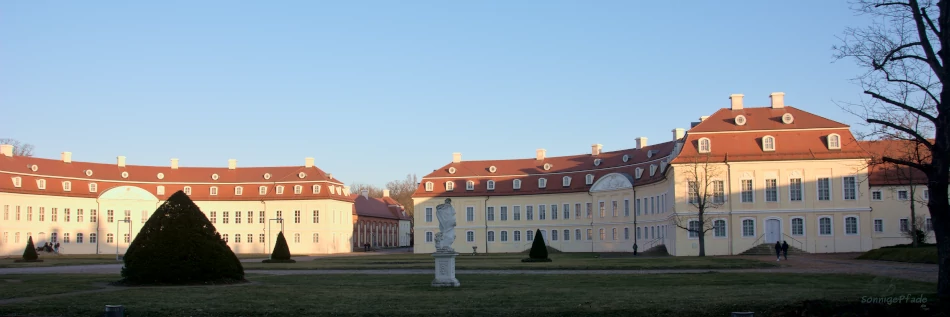
In February 1763, the peace negotiations to end the Seven Years‘ War are underway, in Paris and at Hubertusburg hunting lodge. Because the castle is plundered, the negotiators have to borrow chairs, tables and furniture from neighboring inns. On February 15, 1763, the contracts are signed at Hubertusburg Castle. The confirmation by the Prussian King Frederick II takes place on February 21 in the nearby Dahlen Manor, where he had taken up quarters. The Saxon Elector Friedrich August II confirmed the treaties on February 24 in Warsaw, Austria on the same day in Vienna. Thus the Hubertusburg Peace came into force on March 1, 1763.

hunter’s oak column
After the end of the Seven Years‘ War by the Hubertusburg peace the last large court hunt took place in the autumn 1763. This must have led far into the Dahlen Heath. At the hunter’s oak, a central crossroads in the middle of the wooded areas of the Dahlen Heath, a wooden memorial column has stood since then in remembrance of this court hunt, on which all the notable participants of the Saxon Electoral Court are listed.
Memorial stone at the castle – Thomas Freiherr von Fritsch

One of the negotiators at Hubertusburg Castle in Wermsdorf was Baron Thomas von Fritsch. He himself was strongly affected by the plundering of the Prussians in Electoral Saxony during the Seven Years‘ War. Therefore, already during the war, he turned to the Elector and his Premier in Warsaw. He was commissioned to draw up a plan for the reconstruction of Electoral Saxony and to take part in the negotiations in Hubertusburg for the conclusion of peace. What Baron Thomas von Fritsch put together was a general plan for the renewal of the state of Saxony, which actually ensured a rapid recovery from the war damage, instigated reforms and influenced the development of Saxony for a good hundred years. Next to the Hubertusburg Palace there is a memorial stone in honor of Baron Thomas von Fritsch.
From the penal institution to the neurological clinic – subsequent uses
After the great times of the splendid par force hunts at Hubertusburg Castle had come to an end, the complex was used for various other purposes – as a faience factory (a special kind of ceramics), as a penal institution (Wilhelm Liebknecht and August Bebel, forefathers of German Social Democracy, spent two years here in „fortress custody“), as an insane asylum, orphanage, etc.

During the GDR times (socialist aera in East Germany from 1949 to 1989), Hubertusburg was mainly known as a psychiatric clinic. The buildings fell into disrepair and the splendor could only be guessed at.
Even today, a part of the Hubertusburg is used as a neurological clinic, as an addiction hospital and as a specialized clinic for child and youth psychiatry. In some cases, new buildings have been added to the existing buildings.
Restoration efforts and exhibition plans
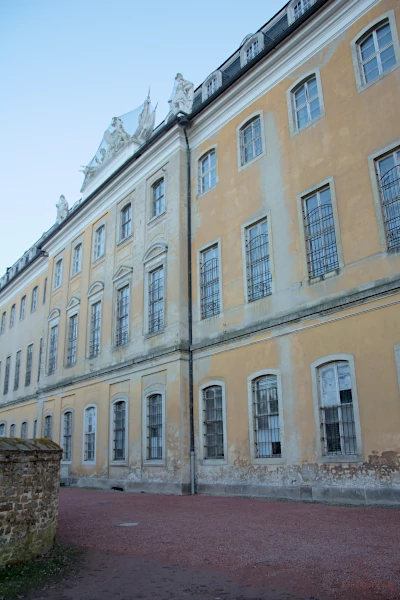
Since the turn of the millennium, the Free State of Saxony has slowly been able to turn its attention to the historic property of Hubertusburg Hunting Palace. The first renovations were carried out, but for a long time a suitable utilization concept was lacking. Parts of the Saxon State Archives have moved into one of the buildings. In 2013, an exhibition of the Saxonian State Art Collections from Dresden was brought to Wermsdorf and shown in the Hubertusburg Palace for the first time. The response was great and encouraged that it could become more. In the meantime, the Saxon parliament has approved the funds for a new exhibition in the summer season, so that starting in May 2022, parts of the Saxon Art Collections will probably again be sent on their journey to Wermsdorf and then be on display in Hubertusburg Castle.
Even if rear parts of the palace are still unrenovated, the entire palace complex is worth seeing. Personally, I think it’s better if everything doesn’t always look „completely renovated“, as if it was just finished yesterday. In my opinion, old buildings can also be seen to have suffered a little from the „ravages of time“. Only if real building damages threaten, should be intervened fast – and for it other architectural monuments can wait calmly also times something….
Visiting Tours of Hubertusburg Castle
The exterior of the Hubertusburg castle and the buildings can be visited at any time. The building complex is well worth seeing, a tour of the freely accessible facilities can take up to an hour.
Since March, 2022, the municipality of Wermsdorf, together with the Friends of Hubertusburg Castle Association, has offered guided tours of the castle every Sunday in March and April – for the time being, until the next exhibition begins in May. For the guided tours you can meet at 2 p.m. in front of the main entrance to the palace. Tickets can be purchased online in the booking system wermsdorf.de for 5.50€ or up to 30 min before the start of the tour in the Café am Schloß for 6 €. Larger groups can arrange a desired date outside these times with the Tourist Information Wermsdorf – Tel: 034364 81 132 or by eMail at info@wermsdorf.de The public visiting tours in the Hubertusburg last about an hour.
During the summer exhibitions at Hubertusburg Castle, guided tours take place during opening hours (Thursdays to Sundays, tours start at 2 p.m., Saturdays and Sundays also at 11 a.m.)
[Contains advertising!]
A piece of food in between
If you want to eat before or after the tour of the Hubertusburg, you can do it right in the neighborhood – in the Café am Schloß in Wermsdorf Schloßstraße 20 (20 Castlestreet). There you can get sweets like coffee and cake, small snacks and for those who spontaneously decide to participate in the tour on Sundays, there are also remaining tickets until 1:30 p.m.

In addition to ice cream, cakes and strudel, the menu at the Wermsdorf Café am Schloß mainly offers delicious waffles with various toppings. A large part of it is sweet and hot, you can also put together the mixture yourself. If you like it more savory, you can choose the right thing to eat under „potato – waffles„. A vegetarian version of the potato – waffles with tomato salad, one with ham and one with salmon are offered.

The Old Hunting Lodge Wermsdorf
And if you are already in the Schloßstraße, you should walk down it. Because actually the Schloßstraße could be called Schlösserverbindungsstraße (Castlesconnectingstreet) – from the castle Hubertusburg it leads down the hill directly into the courtyard of the Renaissance Old Hunting Lodge of Wermsdorf. In five minutes you are there! The ensemble together with the horse stables on the left and the village church on the right is quite impressive, especially from this direction. Of course, the old Renaissance hunting lodge takes a back seat to the magnificent baroque Hubertusburg. But for the fact that there are two castles in a small village like Wermsdorf, it is worth the short walk!
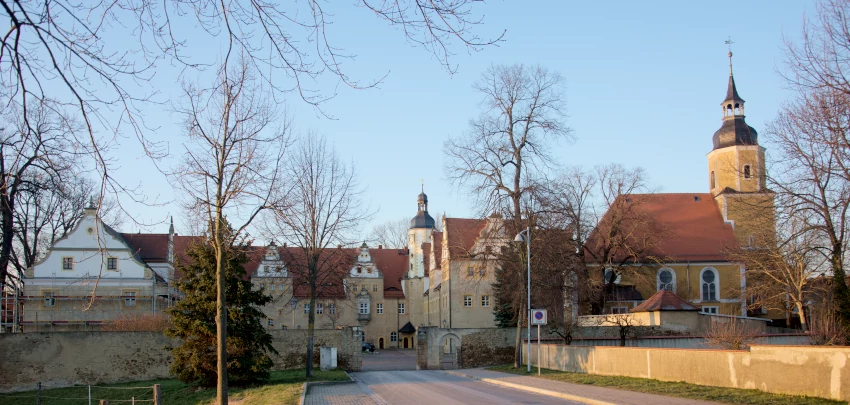
The Old Hunting Lodge Wermsdorf is a Renaissance castle from the 17th century. Before there was already a manor there. However, a new, larger castle was commissioned on the site by Elector Christian II and built from 1609 to 1610. His successor, Elector Johann Georg I, had it transformed into a Renaissance building as a hunting lodge between 1617 and 1626. The three-winged complex met the requirements of that time as a hunting lodge. When the newly built Hubertusburg Palace took over this function from 1721, the hunting lodge only served to accommodate staff and guests.
In 1875-76, under the late Saxon King Albert, the old hunting lodge in Wermsdorf was once again rebuilt. King Albert, who was very popular with the people, often stayed at the Old Hunting Lodge with his wife, either for short visits or for several days. Hunting played a major role there as well, but Albert met with local celebrities and visitors during this time.
Since the 1990s, the Old Hunting Lodge has been the property and seat of the municipality of Wermsdorf. Among other things, there is a small tourist office there, which, however, is rather open during working hours of the public service – especially not on weekends.
To the hunting lodge Wermsdorf belonged also stables of the royal marstall. These are still used today by the Wermsdorf Riding and Driving Club, among others. Already in the 30s of the 20th century a new riding hall was added.
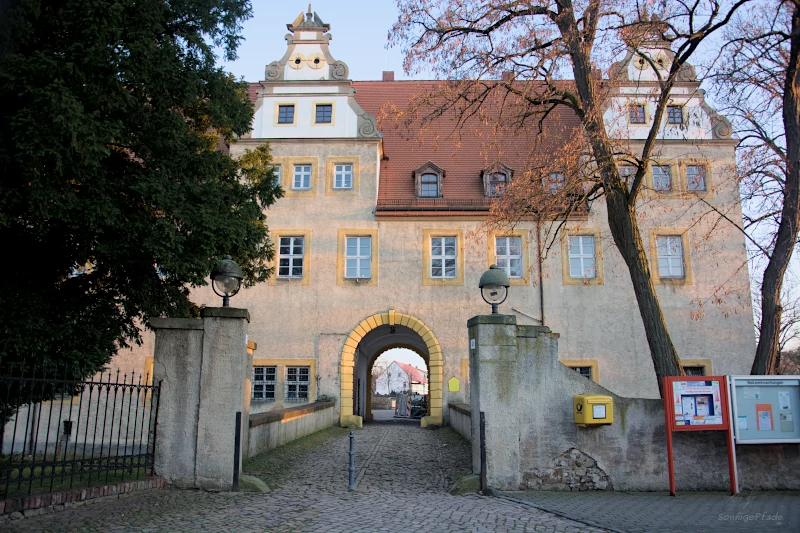
Feasting after the sightseeing tour
If you want to feast a little like the Saxon nobility at Hubertusburg Castle, you will find a chocolaterie in Wermsdorf. At Bischofsweg 29a (bishops alley), the local chocolatier Olav Praetsch runs his store and also welcomes customers on site. (Wednesday to Saturday 10 a.m. – 6 p.m., Sunday 2 p.m. – 6 p.m.)
If the May 2022 exhibition at Hubertusburg comes to fruition, he will probably open a seasonal branch on the castle grounds, as he has during previous major events, and operate it in parallel with the permanent location in Bischofsweg.
Following the hunting parties – tracks in the Wermsdorf forest
Wermsdorf is surrounded on three sides by the Wermsdorfer Forest – the fourth southern side is formed by dammed lakes of the Döllnitzaue.
The Wermsdorfer Forest stretches from Sachsendorf in the west to over the Collm Hill in the east on about 13,000 ha. as a landscape conservation area. The Wermsdorfer Forest is often mentioned in the same breath as the Dahlener Heide, a large landscape conservation area further north. But in between there are not only large fields, but also the federal highway B6 and the railroad line Leipzig – Dresden. This is a pretty hard dividing line, especially for wildlife, but also a mental border for the people of the region.
To me, the Wermsdorf Forest seems to be quite flat, except for the mountain slopes of the Collm Hill (313m) and the Reichenbach Hill in the northwest with 206m, which, however, is already north of the mentioned B6 and the railroad line. Together with the dead-straight and right-angled aisles, this all makes a rather boring impression. There is the richer structured Dahlener Heide north of B6 and railroad line for me but a lot more varied. Interesting in the Wermsdorf forest is the east at the Collm and in the west the area near Sachsendorf with its pond landscape.
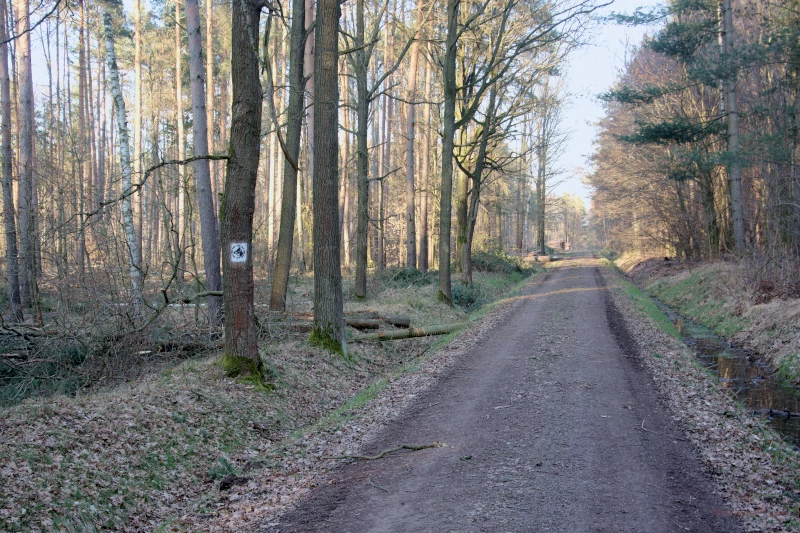
Sights in the Wermsdorf Forest
The Wermsdorf Forest also has some attractions. By the way, the already mentioned straight paths laid out at right angles were also intended to make par force hunting easier for the mounted nobility.
Several ponds and brooks can be found in the Wermsdorfer forest, among them east of Sachsendorf a chain of several ponds (Reiherteich, Doktorteich, Kirchenteich, Zeisigteich..-teich means pond). The fields of the Wermsdorf Forest also form a watershed between the Mulde River in the west and the Elbe River in the east.
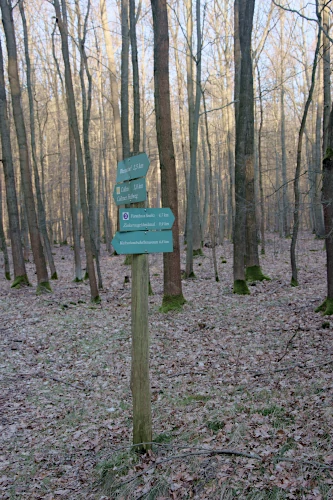
The most important paths are signposted. Several hiking routes have been established to explore the surroundings of Wermsdorf on foot. One starting point is at the old hunting lodge, the second is the restaurant at the Horstsee lake south of the village center (direction Mutzschen/ highway). Also a branch of the „Mulde – Elbe – Cycleroute“ crosses Wermsdorf and the Wermsdorf Forest.
Near Sachsendorf there is a „cultural landscape museum„, including a forest classroom as well as settlement evidence such as the desert Mark Wyperniswalde or the desert village Nennewitz.
Between Sachsendorf and Fremdiswalde there is also a burial mound from the Early Bronze Age.
Near Wermsdorf there is the grave and a stone for Carl Zinkernagel. Zinkernagel was a forester in the Wermsdorf forest in the middle of the 19th century and introduced a number of innovations in the forestry use of the forest. He was the first non-noble forester in Saxony. The memorial stone for the forest master Carl Zinkernagel (1802 – 1887) is located in the eastern Wermsdorf forest, somewhat hidden in the middle of an oak grove that he once planted himself.

Collm hill – mountain peak at the eastern edge of the Leipzig lowland bay
The Collm hill in the east of the Wermsdorf Forest is with 313m the highest mountain in North Saxony. On the top of the mountain is the Albertturm, an 18m high observation tower from 1854. More conspicuous, however, is a 100m high transmission tower of the Telekom. Since 2004, this has replaced a radio and telecommunications tower of the GDR from 1957, which was demolished in 2005.
On the northwest flank of the Collm is a conspicuous white building. This is the Collm observatory of the University of Leipzig. This earthquake observatory was built between 1927 and 32 and has been recording all earthquake events in the world without any gaps ever since. Wind speeds in the high atmosphere are also measured from there.
Below the Alberttower there is a medieval rampart, which is estimated to have been built between 900 and 930.
In the small village of Collm, east of the mountain peak, an approximately 1000-year-old lime tree in the cemetery next to the church is worth mentioning.
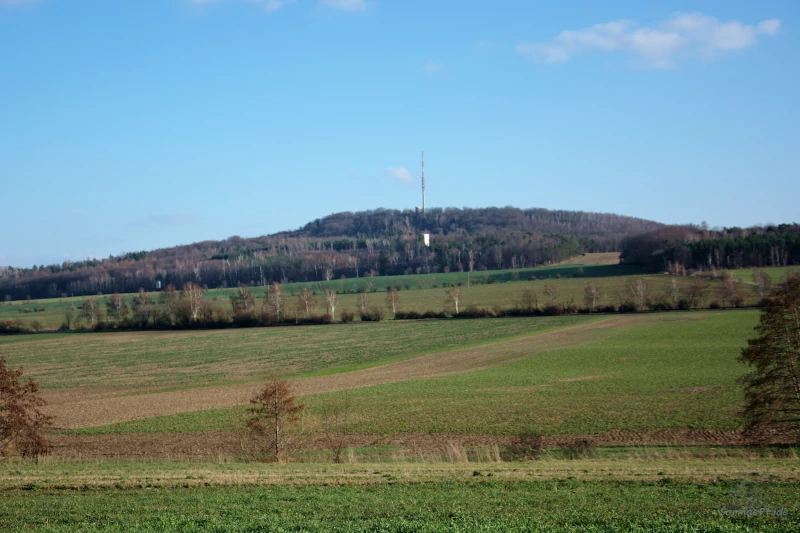
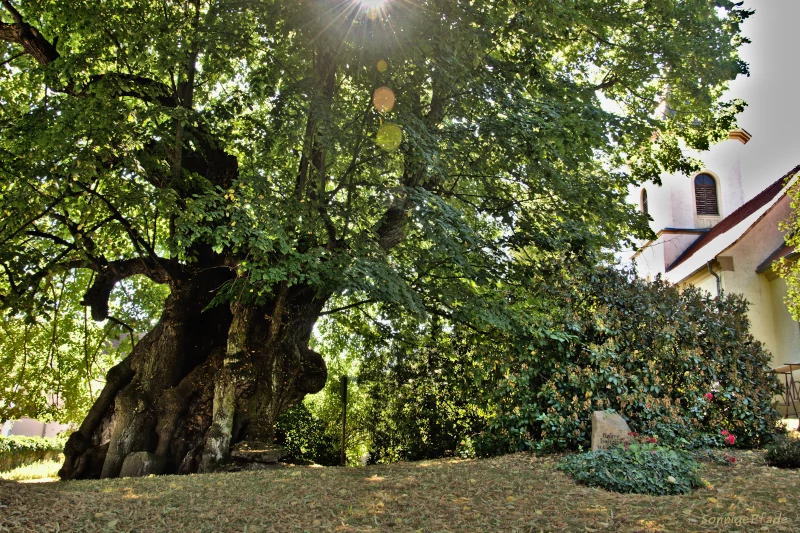
Hubertusburg Castle Wermsdorf – Exhibition 2024
The negotiations on the Hubertusburg Peace and the connection between the historical site and the forest, hunting, water and pond management are to be reflected in a comprehensive theme:
Water School. A speculation in four seasons
Peaceful use of resources was not only the subject of the negotiations on the Peace of Hubertusburg, but is once again part of the discourse on changes in land use and organization. And in connection with this, power structures, the distribution of resources and ownership structures.
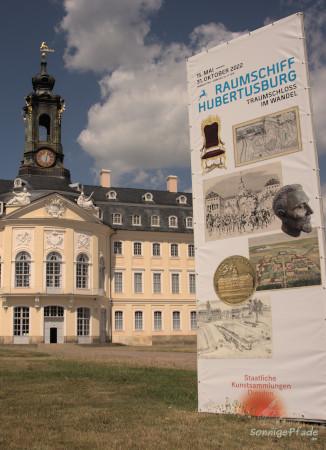
The exhibition is divided into four areas of change, analogous to the seasons. The setting includes the “Water School” – a summer seminar by the Rotterdam studio Makkink & Bey. For the first time in Germany and for the first time in a rural area. Workshops and events will explore the potential for improving quality of life through design in rural areas.
The exhibition “Water School. A speculation in four seasons” will be open to visitors at Hubertusburg Wermsdorf from May 26 to October 15, 2024. Opening hours are from Thursday to Sunday, 10 am to 5 pm.
Guided tours and tours are usually offered from Friday to Sunday at 2 p.m. Sa and Su also at 11 a.m.
Travel tips for Hubertusburg Castle, Wermsdorf and the Wermsdorf Forest
The journey to Wermsdorf
By car
South of Wermsdorf runs the A 14 freeway from Dresden to Leipzig. You can leave it at the Mutzschen junction and head north on the S38 to Wermsdorf.
If you prefer to travel a little slower and more quietly, you can use the good old highway F6, well, today B6 between Dresden and Leipzig. When you are coming from Dresden, turn off in Oschatz in the direction of Wermsdorf. If you come from Leipzig, you can turn right in Luppa to Wermsdorf and come through the Wermsdorf forest via the S24 to Wermsdorf.
The nearest airport to Wermsdorf ist Leipzig – Halle airport (LEJ) directly at the A 14 freeway. Shure, there is a car renting service* too.
Parking is easy around Hubertusburg Castle – there are several visitor parking lots, especially on the east side. There are also large hikers – parking lots in several places in the Wermsdorf Forest.
By train, by bike and by hiking
Since Wermsdorf does not have a direct train connection (anymore), the journey is only possible to a nearby train station. From there you either have to change to a bus or use a own bicycle. If you feel like it, you can also hike to Wermsdorf.
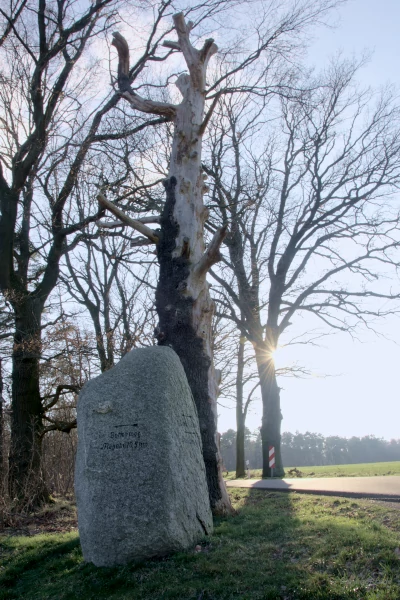
The nearest train station is Dahlen (Saxony), which is also the (southern) gate to the Dahlener Heide. From there, the route via Malkwitz is recommended by bike, as very small, narrow roads can be used for this. Unfortunately, there is nevertheless relatively much traffic. From the Wermsdorf forest there are then even forest paths without car traffic. There is also a bus connection Dahlen – Wermsdorf – Mügeln on the line 816, which is called „Taktbus – line“. These buses run from Monday to limited 4x on Saturday, but not on Sunday.
Further away in the east is the station Oschatz. From there, buses run as the so-called +Plus bus line 801 to Wermsdorf. These also run 6x on Saturdays and 4x on Sundays in each direction. If you want to hike, you can start in Oschatz and hike initially on smaller roads, later on forest paths to the little village Collm on the mountain and from there through the Wermsdorf forest to Wermsdorf village and Hubertusburg Castle.
Wermsdorf, Dahlen and Oschatz belong to the traffic association Mitteldeutscher Verkehrsverbund mdv in the Leipzig metropolitan area. In the mdv, bicycle transportation is free of charge on the train.
Accommodation in the surroundings of Wermsdorf
Below are some mostly rather rural accommodations in the vicinity of Wermsdorf, which provide for a good stay in the region between Döllnitz, Collm and Dahlener Heide. However, there is still a journey to be made to the town of Wermsdorf itself and to Hubertusburg Castle:
Although the Sinnes Wandel Hof Serka* is listed with „Grimma“ as its address, the little village of Serka is much closer to Wermsdorf – it only takes about 11km to get to Hubertusburg Castle. Two apartments for up to 4 persons are rented, with the sofa bed in the living area the number of guests can be extended. The kitchens of the holiday apartments allow complete self-catering, also for families. Children will find a playground in the garden. A number of animals live on the farm, also for therapeutic purposes. The children can take part in feeding them, for example. In the garden can also be barbecued. Pets are allowed. For motorists, the exit Mutzschen on the A14 is nearby, there is parking at the farm.
A two-bedroom apartment for four guests is offered by Rittergut Oetzsch* in the Döllnitzaue between Oschatz and Mügeln. For self-caterers, the holiday apartment has a kitchen. With 120sqm there is enough space in the vacation apartment. The journey can be made from the train station Oschatz even with the „Wild Robert„, the narrow-gauge railroad in the Döllnitztal. Steam trains also run frequently on weekends. For the Oetzsch manor, the Schweta stop is the right station. for motorists, there is free parking at the accommodation.

In Heyda near Börln and thus on the edge of the Dahlener Heide you will find the beautiful Villa Rosencottage*. This vacation home offers space for four people with its own kitchen, garden, pond, playground at the house and romantic – cozy atmosphere. Many guests are especially enthusiastic about the peace and quiet.
The vacation home is located on the grounds of the Old Castle Heyda directly next to the manor house. Wermsdorf is here on the other side, so south of the railroad and B6. The accommodation is especially suitable if you want to explore both Wermsdorf with Hubertusburg and forest and the Dahlener Heide. Bicycles are highly recommended, especially in the summer season, then it is not far for a refreshing swim to the Dammühlenteich near Ochsensaal or the bath – gravel pit in Luppa. Even the Hohburg hills can be reached in 8km, but the way there leads over local roads and is not suitable for hiking.
Also at the castle you will find the Villa Rittergut Heyda*. This offers space for four guests in a self-contained vacation home with two bedrooms and large bright rooms. For cooler days, the fireplace can be heated. A playground is available on the farm. Self-catering guests will find a well-equipped kitchen. Hiking, cycling and also horse riding are possible in the surroundings of Heyda.
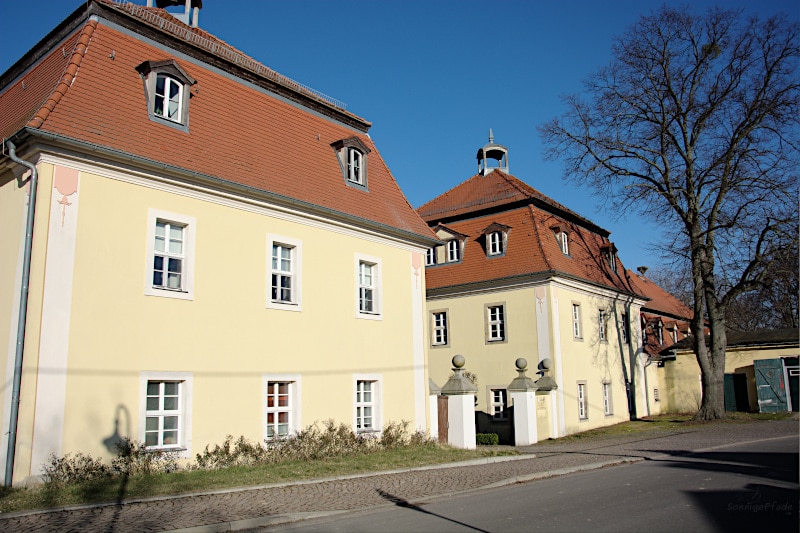
If all this was too rural for you, then choose Pension Holly in Oschatz* It is centrally located in the city center of Oschatz and offers a pleasant guest room for two. Pets are allowed. Parking spaces are included. Between Oschatz and Wermsdorf lies, as described above, the Collm. Here a train journey is possible in the best way, because Oschatz lies at the railroad line Leipzig – Dresden. To get to Hubertusburg, you can use the +Bus – Line 801 as described above. Or at least walk comfortably on a route via Collm and Wermsdorfer Wald. In Oschatz there is a leisure spa pool „Platsch“.
Wermsdorf – and Hubertusburg – Hiking map

Dahlener Heide*
The cycling and hiking map „Dahlener Heide „* also includes the Wermsdorfer Wald (the Hubertusburg even adorns the title page) and is thus well recommended for hikers and cyclists who want to explore this North Saxon region between Mulde and Elbe, Schildberg hill and Collm hill in more detail.
Let’s go on a merry hunt! – With friends to the Hubertusburg…
If you want to invite your friends to join you on a trip to Wermsdorf, share the link to this post on your social media channels!
As a little summary here a „Hubertusburg FAQ„:
The Saxon baroque hunting lodge Hubertusburg is located in Wermsdorf, East Germany, between Leipzig and Dresden.
Wermsdorf is located in East germany, northern Saxony between Leipzig and Dresden, but closer to Leipzig (about 45km east). You can reach Wermsdorf via the railroad line Leipzig – Riesa – Dresden with an exit in Oschatz and a ride with the Plus-Bus 801 or by car via the A14 Leipzig – Dresden, exit Mutzschen.
Hubertusburg Castle was built as a hunting lodge by order of the Saxon electors of the 18th century. The Saxon electors of that time were at the same time king of Poland. Thus, Hubertusburg Castle was used as a court for Saxons and Poles during the annual court hunts in autumn. Responsible for the new construction of Hubertusburg Castle was Elector Friedrich August I – August the Strong and King August II of Poland. The reconstruction took place during the residence of Elector Friedrich August II / King August III of Poland.
The construction of the Hubertusburg took place in two stages. At the court hunt in November 1721 the new building was announced and started. In 1728 the construction was finished as a three-winged palace with a court of honor. The extension of the palace building to its present dimensions took place from 1743 to 1753.
From 1756 to 1763, Central Europe was scarred by the Seven Years‘ War. A coalition led by the Habsburgs of Austria with Saxony as an ally fought against Prussia. At the beginning of 1763, peace negotiations took place, including at Hubertusburg Castle, which had previously been sacked by the Prussians. One of the leading mediators for Saxony was Baron Thomas von Fritsch. On February 15, the Hubertusburg Peace was concluded, ending the Seven Years‘ War.
The grounds of Hubertusburg Castle can be visited at any time, the grounds are freely accessible. For the palace of Hubertusburg itself there are so far only changing possibilities approximately from March to October of the year. An association „Friends of Hubertusburg“ makes it possible to visit the front wing on weekends as part of public tours, so far 11 am and 2 pm. Information and booking via Wermdorf tourist information. If exhibitions of the Saxon Art Collections Dresden take place in the Hubertusburg, the visit and the inspection is usually possible from Tuesday to Sunday. These exhibitions are limited to the summer season from May to October. Guided tours are then also possible on weekends.
The main attraction in Wermsdorf is of course the baroque hunting lodge Hubertusburg with all its facilities. But in the village, only a few hundred meters away from the Hubertusburg, there is also the old hunting lodge of the Saxon electors, which was built in the Renaissance and is today mainly the seat of the municipal administration. Next to it the village church completes the ensemble. In front of the old hunting lodge there is a monument to the Saxon King Albert, who liked to go hunting in Wermsdorf and was very popular. If you like hiking, you can visit some historical places in the Wermsdorf forest north of the village, such as a deserted (abandoned place) castle Hayn or the Zinkernagel – monument to a local forest reformer.
For the hunger before or after the sightseeing tour in the Hubertusburg is the castle café a recommendation. There you can find not only ice cream and sweet treats, but also a hearty snack, for example, filled waffles (topped with ham, salmon or vegetarian). The Café am Schloß is located at Schloßstraße 20 in front of the northern entrance to Hubertusburg Castle. Popular for eating is the restaurant at the Horstsee south of Wermsdorf. If you like it sweet, you can even find a chocolatierie in Wermsdorf. This is run by chocolatier Olav Praetsch in Bischofsweg.
Note on * advertising links
Some links in this post are marked with * and connect you to agencies or online – stores. If you buy something there, the „sonnige pfade“ blog receives a small commission to cover the expenses. Nothing will be more expensive for you, because the commission is already calculated in the pricing.
Picture source product pictures: Manufacturer / Dealer
